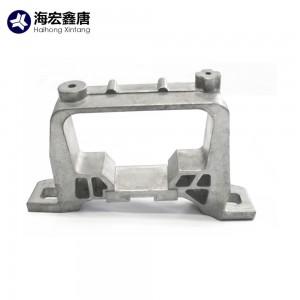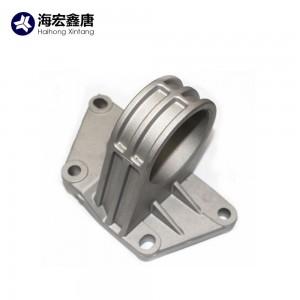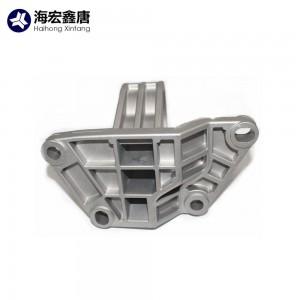How Aluminum Die Castings Car Parts Drive Innovation in Automobiles

Aluminum die castings car parts help shape the future of vehicles. Engineers choose these components for their strength and lightweight properties. Many manufacturers rely on OEM aluminum die castings car parts to improve how cars handle and last. Die castings car parts also allow designers to create new shapes and features. These parts support better performance and greater efficiency.
Key Takeaways
- Aluminum die castings create strong, lightweight car parts that improve vehicle performance and fuel efficiency.
- The high-pressure die casting process produces precise parts with complex shapes, helping car makers design safer and more innovative vehicles.
- Using aluminum parts reduces car weight, which leads to faster acceleration, better handling, and lower fuel costs.
- Mass production with aluminum die casting lowers manufacturing costs and speeds up delivery while keeping quality consistent.
- Recycling aluminum saves energy and reduces waste, making aluminum die castings a sustainable choice for the automotive industry.
Aluminum Die Castings Car Parts: Process and Advantages

What Is Aluminum Die Casting?
Aluminum die casting is a manufacturing process that shapes molten aluminum into strong, precise parts. Factories use this method to make many car components. The process uses special molds called dies. These dies help create parts with exact shapes and sizes. Aluminum die castings car parts often replace heavier metal parts. This change helps cars become lighter and more efficient.
How the Die Casting Process Works
The die casting process starts with melting aluminum alloys. Workers pour the liquid metal into a machine. The machine injects the metal into a steel mold under high pressure. This pressure forces the metal to fill every space in the mold. After the metal cools, the machine opens the mold and removes the new part. Factories then trim and finish each part to remove any rough edges.
Tip: High-pressure die casting creates parts with smooth surfaces and tight tolerances. This means the parts fit together well and work better in cars.
Many factories use advanced machines to control the process. These machines help make each part the same as the last one. Companies like HHXT use CNC machining centers to add extra details and ensure accuracy. This step allows for custom shapes and sizes, which helps car makers design new features.
Unique Benefits for Automotive Applications
Aluminum die castings car parts offer many benefits for the automotive industry. These parts weigh less than steel parts, which helps cars use less fuel. Lighter cars can also accelerate faster and handle better. Aluminum resists rust, so these parts last longer even in harsh weather.
Here are some key advantages:
- Strength and Durability: Aluminum alloys provide strong support for important car systems.
- Precision: The die casting process creates parts with exact measurements.
- Complex Shapes: Factories can make parts with detailed designs that would be hard to create with other methods.
- Cost Savings: Mass production lowers the price of each part.
- Better Performance: Lighter and stronger parts improve how cars drive and feel.
| Benefit | Description |
|---|---|
| Lightweight | Reduces overall car weight |
| Corrosion Resistant | Lasts longer in tough conditions |
| High Precision | Ensures perfect fit and function |
| Customizable | Allows for unique shapes and features |
Aluminum die castings car parts help car makers build vehicles that are safer, more efficient, and more innovative. These advantages make them a popular choice in modern automotive design.
Driving Lightweight and Fuel-Efficient Vehicles
Reducing Vehicle Weight for Better Performance
Car makers always look for ways to make vehicles lighter. Lighter cars move faster and handle better on the road. Aluminum parts help reduce the weight of many car systems. For example, shock absorber supports made from aluminum weigh much less than steel ones. This change makes the car easier to control, especially when turning or stopping.
A lighter car also puts less stress on its engine and brakes. The engine does not have to work as hard to move the car. The brakes can stop the car more quickly. Drivers notice these changes in smoother rides and better safety.
Note: Many sports cars and electric vehicles use lightweight aluminum parts to boost speed and agility.
Here are some ways lighter parts improve performance:
- Faster acceleration
- Shorter stopping distances
- Better cornering and handling
- Less wear on tires and brakes
| Feature | Benefit for Drivers |
|---|---|
| Lower weight | Quicker response |
| Strong support | Improved safety |
| Less strain | Longer part lifespan |
Enhancing Fuel Efficiency and Lower Emissions
Fuel efficiency matters to both drivers and the environment. When a car weighs less, it uses less fuel to travel the same distance. This means drivers save money at the gas pump. It also means the car releases fewer harmful gases into the air.
Aluminum parts help car makers meet strict rules about fuel use and pollution. By using lighter materials, companies can design cars that pass these tests more easily. Many new vehicles now use aluminum for key parts like engine mounts, suspension supports, and body frames.
Some benefits of better fuel efficiency include:
- Lower fuel costs for families
- Fewer trips to the gas station
- Reduced carbon dioxide emissions
- Cleaner air in cities and towns
Tip: Choosing cars with lightweight parts helps protect the planet for future generations.
Car makers like HHXT use advanced methods to create strong, light parts. These parts help vehicles run better and last longer. As more companies use aluminum die castings car parts, the world will see cleaner and more efficient cars on the road.
Enabling Advanced Designs and Complex Geometries

Precision Engineering for Custom Car Parts
Automotive engineers need parts that fit perfectly. Aluminum die casting allows them to create car parts with exact shapes and sizes. This process uses high-pressure machines and detailed molds. Each part comes out with smooth surfaces and tight tolerances. Factories like HHXT use advanced CNC machining centers. These machines cut and shape parts with high accuracy. As a result, car makers can order custom parts for different models and years.
Engineers often need parts with special features. For example, a shock absorber support may require extra holes or unique curves. Aluminum die casting makes these changes possible. Factories can adjust the mold or use CNC machines to add details. This flexibility helps car makers design safer and more reliable vehicles.
Note: Precision engineering reduces waste and saves time during assembly.
Supporting Innovative Automotive Designs
Modern cars look and perform better because of new design ideas. Aluminum die casting supports these ideas by making complex shapes easy to produce. Designers can create parts with thin walls, hollow sections, or intricate patterns. These shapes help reduce weight and improve airflow around the car.
Automotive companies want cars that stand out. Unique designs attract buyers and improve performance. Aluminum die casting lets designers try new ideas without high costs. Factories can quickly change molds or adjust production for new models.
Here are some ways advanced designs help:
- Better fuel efficiency from lighter parts
- Improved safety with stronger supports
- Sleek looks that appeal to drivers
| Design Feature | Benefit |
|---|---|
| Thin walls | Lower weight |
| Complex patterns | Unique appearance |
| Hollow sections | Improved performance |
Car makers rely on precision and flexibility to stay ahead. Aluminum die casting gives them the tools to build the cars of tomorrow.
Cost-Effectiveness and Scalability in Production
Mass Production of Aluminum Die Castings Car Parts
Automotive factories need to make thousands of parts quickly. Aluminum die casting helps them reach this goal. The process uses strong molds that can create the same part many times. Each cycle takes only a few seconds. This speed allows companies to fill large orders without delays.
Factories like HHXT use advanced machines to keep every part the same. These machines work day and night. Workers check the parts to make sure they meet quality standards. The molds last for many cycles, so companies do not need to replace them often. This saves time and money.
Fact: Mass production with die casting supports the needs of big car makers around the world.
A table below shows how mass production helps:
| Benefit | Description |
|---|---|
| Fast output | Makes thousands of parts quickly |
| Consistent quality | Every part matches the design |
| Less waste | Uses materials more efficiently |
Lowering Manufacturing Costs and Lead Times
Car makers want to save money and deliver cars faster. Aluminum die casting helps lower costs in several ways. The process uses less material because the molds are precise. Factories waste less metal, which keeps prices down.
Short lead times mean customers get their parts sooner. HHXT uses CNC machines to finish parts quickly. Workers can switch between different designs without long delays. This flexibility helps car makers respond to new trends.
Tip: Lower costs and faster delivery help car companies stay competitive.
A few ways die casting reduces costs and time:
- Less manual labor needed
- Fewer mistakes during production
- Quick changes for new models
These benefits make aluminum die casting a smart choice for modern car manufacturing.
Technological Advancements and Future Trends
Automation and Smart Manufacturing in Die Casting
Factories now use robots and smart machines to make car parts. These machines work quickly and do not get tired. Workers use computers to control the machines and check each step. Sensors watch the process and send alerts if something goes wrong. This helps factories make more parts with fewer mistakes. Smart manufacturing also saves energy and materials. Many companies use these systems to keep up with high demand and to improve quality.
Note: Automation lets factories run day and night, which means cars get built faster.
New Aluminum Alloys and Material Innovations
Engineers keep looking for better materials. They mix aluminum with other metals to make new alloys. These new alloys are stronger and lighter than before. Some alloys resist heat and rust better. Car makers use these materials for parts that need to last a long time. New alloys help cars stay safe and use less fuel. Factories test each new material to make sure it works well in real cars.
A table below shows some benefits of new alloys:
| Alloy Feature | Benefit for Cars |
|---|---|
| Higher strength | Safer and tougher parts |
| Less weight | Better fuel economy |
| More resistance | Longer part lifespan |
Integration with 3D Printing and Digital Technologies
3D printing changes how factories design and test car parts. Engineers use computers to create digital models. They print these models to see how a part will look and fit. This helps them find problems before making the real part. Digital tools also help factories track each part from start to finish. These technologies make it easier to create custom parts for different car models.
Tip: 3D printing helps car makers try new ideas quickly and at a lower cost.
Sustainability and Recycling Initiatives
Car makers today focus on building vehicles that help protect the environment. They choose materials and processes that use less energy and create less waste. Aluminum stands out as a sustainable choice for automotive parts. It can be recycled many times without losing its strength or quality.
Factories collect scrap aluminum from production lines. They melt this scrap and use it to make new car parts. This process saves energy because recycling aluminum uses much less power than making new metal from ore. For every pound of recycled aluminum, factories save about 95% of the energy needed to produce new aluminum.
♻️ Recycling aluminum helps reduce greenhouse gas emissions and keeps waste out of landfills.
Many companies set up closed-loop recycling systems. In these systems, leftover aluminum from manufacturing goes back into the process. This approach cuts down on raw material use and lowers costs. Car makers also work with suppliers to make sure all parts meet strict environmental standards.
A table below shows the benefits of aluminum recycling in the auto industry:
| Benefit | Impact on Environment |
|---|---|
| Lower energy use | Reduces carbon footprint |
| Less landfill waste | Cleaner communities |
| Reusable material | Supports circular economy |
Some car makers label their products to show recycled content. This helps buyers make greener choices. As more people care about the planet, the demand for sustainable car parts grows. Companies like HHXT lead the way by using advanced recycling methods and eco-friendly production steps.
Note: Choosing recycled aluminum parts supports a cleaner, more sustainable future for everyone.
Real-World Applications and Case Studies
Aluminum Die Castings Car Parts in Engine and Suspension Systems
Automakers use aluminum die castings car parts in many engine and suspension systems. These parts include engine mounts, cylinder heads, and shock absorber supports. Aluminum parts help engines run cooler and last longer. They also make suspension systems lighter and stronger. Lighter suspension parts improve how a car handles on the road. Many car brands choose aluminum for these systems because it resists rust and keeps cars safe.
Note: Lighter engine and suspension parts help cars use less fuel and reduce wear on other components.
Electric Vehicle Components and Innovations
Electric vehicles (EVs) need parts that are both light and strong. Aluminum die castings play a big role in EV design. Makers use aluminum for battery housings, motor mounts, and cooling systems. These parts help keep the car’s weight low, which means the battery lasts longer on each charge. Aluminum also helps protect important EV parts from heat and damage. As more people choose electric cars, the demand for advanced aluminum parts continues to grow.
A few key uses in EVs:
- Battery enclosures
- Inverter housings
- Lightweight motor supports
Case Study: HHXT OEM Aluminum Die Castings Car Parts
HHXT produces OEM aluminum die castings for car parts like shock absorber supports. The company uses high-pressure die casting and advanced CNC machines. These methods create parts with exact shapes and smooth surfaces. HHXT’s parts fit popular models such as Toyota Corolla and Audi R8. The company tests each part many times to ensure quality and safety. Customers can request custom designs for their vehicles. HHXT also offers surface treatments to protect parts from rust and wear.
| Feature | Benefit |
|---|---|
| Custom machining | Fits many car models |
| Surface treatment | Longer part lifespan |
| Strict testing | Reliable performance |
Tip: HHXT’s experience and technology help car makers build safer, more efficient vehicles.
Aluminum die castings car parts play a key role in the progress of the automotive industry. These parts help vehicles become lighter, stronger, and more efficient. Engineers continue to develop new materials and better manufacturing methods. Companies also focus on sustainability. The future of cars will depend on the growth of aluminum die casting technologies.
The journey of innovation in automobiles continues with each new advancement in aluminum die castings car parts.
FAQ
What are aluminum die castings car parts?
Aluminum die castings car parts are components made by forcing molten aluminum into a mold. This process creates strong, lightweight parts for vehicles. Many car makers use these parts to improve performance and reduce weight.
Why do car makers prefer aluminum over steel?
Aluminum weighs less than steel. This helps cars use less fuel and move faster. Aluminum also resists rust, so parts last longer. Many engineers choose aluminum for its strength and durability.
How does HHXT ensure quality in its car parts?
HHXT uses advanced machines and strict testing. Each part goes through several inspections. The company follows international standards like ISO9001:2008 and IATF16949. This ensures every product meets high quality requirements.
Can aluminum die castings car parts be recycled?
Yes, aluminum can be recycled many times. Recycling saves energy and reduces waste. Many factories collect scrap aluminum and use it to make new car parts. This helps protect the environment.
Which vehicles use HHXT aluminum die castings car parts?
HHXT supplies parts for models like Toyota Corolla and Audi R8, Q7, and TT. These parts fit cars made from 2000 to 2016. Car makers choose HHXT for custom and reliable aluminum components.